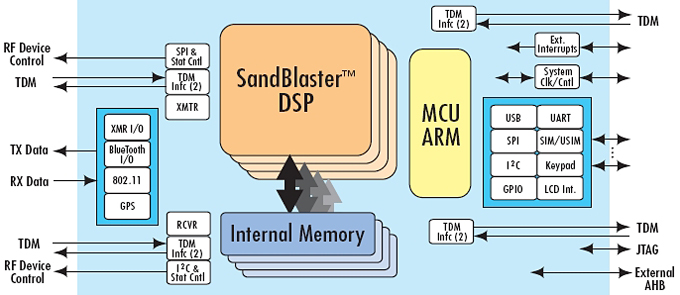Today fabless chip start-up Sandbridge announced its new SB3011 chip, a low-power derivative of the SB3010 chip announced in July 2005. The chip is fully programmable and is aimed at replacing baseband and application processors in cellular handsets. Sandbridge will face stiff competition from dominant players such as TI and Qualcomm that have close relationships with handset manufacturers, but the company remains optimistic; the company recently received $15.4 million in Series B funding led by Samsung Ventures and is predicting volume shipments of the SB3011 in the first quarter of 2007. Sandbridge believes that the SB3011 can compete on cost and energy consumption and that its flexibility to implement multiple standards will give it an advantage over chips utilizing hard-wired accelerators and those in which vendor-supplied software cannot be modified by the system developer.
A fully programmable baseband chip has obvious appeal given the multiplicity of cellular standards and the expected emergence of handsets supporting not only cellular but also WLAN and television receiver functionality. Current baseband chips, most of which incorporate fixed-function hardware, typically support only one communication standard. According to Sandbridge, with its fully programmable chip, multiple standards can be implemented with no change in hardware, allowing for handsets that work across networks using incompatible standards. The chip can also run multimedia codecs, user interfaces, and other code, potentially allowing all processing currently performed on handset baseband and application processors to be handled by the SB3011. Another potential benefit of a fully programmable solution is that implementing algorithms in software is typically quicker and less expensive than designing custom hardware; if the processor is supported with adequate development tools. The SB3011 is programmed in C.
A major problem that has kept fully programmable chips from subsuming baseband chips and application processors is power consumption. Fully programmable solutions in general consume significantly more power than hardwired solutions, making them unsuitable for mobile applications in which battery life is critical. Sandbridge, however, claims that the SB3011 can implement the functionality of a typical hardwired baseband processor with about 10% higher power consumption. Furthermore, Sandbridge believes that in handsets with support for multiple wireless standards and multimedia codecs, the SB3011 can offer better system-level energy efficiency than multi-chip third-generation handset solutions offered by TI and Qualcomm. In Sandbridge’s analysis, multi-chip solutions are inefficient due to factors such as energy consumed by inter-chip communication via shared memories and the separate power management required for each chip.
The heart of the SB3011 is the Sandblaster DSP core, four of which combined with an ARM9 comprise the basic SB3011 architecture as shown in Figure 1. Operating at 600 MHz, the cores feature architectural tradeoffs not seen in most high-performance DSPs. The Sandblaster core has a multi-issue architecture with compound instructions. Sandblaster instruction words are composed of three non-interchangable operations that Sandbridge characterizes as a single compound instruction. Compound instructions typically require fewer bits to encode operations than RISC-like instructions typically found in VLIW architectures. Fewer instruction bits fetched per cycle can result in lower power consumption. However, compound instructions also typically make processors more specialized and make it harder for compilers to generate efficient code.

Figure 1. High-level diagram of the SB3011 chip
The Sandblaster core is also multithreaded, with each core supporting up to eight hardware threads. To conserve power, threads can be turned off when not needed. Sandbridge Chief Technology Officer John Glossner explains, “If waiting for a phone call to come in only requires a couple of threads on a single processor, the rest of the processors and threads are put to sleep so they don’t dissipate power—static or dynamic. This is done under operating system control. When a phone call comes in, the OS brings the other processors back up and processes the voice or data call.” The threads can also be interrupted with single-cycle latency and no loss of state. This is seen by the company as particularly important when supporting multi-mode communications. BDTI has not had the opportunity to evaluate the Sandblaster architecture or software development tools.
To ease development effort for its customers, Sandbridge offers physical-layer baseband software implementing a number of wireless standards including WCDMA, GPRS/EDGE, GPS, WiFi, and WiMax, as well as multimedia codecs such as MP3, MPEG-4, and H.264. Sandbridge states that this software has passed conformance testing and is nearly production-ready. Protocol stacks and handset-vendor proprietary functionality will need to be ported to the SB3011 platform and integrated with Sandbridge code.
As a small startup, Sandbridge will face major challenges breaking into a market dominated by large chip vendors such as TI, Qualcomm, NXP (formerly Philips), and Freescale. When asked about the risk large handset manufacturers take when dealing with a startup whose future is uncertain, Sandbridge CEO Guenter Weinberger replied, “It is the standard issue. The more common day-to-day question is, ‘You’re a 40-person company. Can you support multiple customers?’ I think we’ve demonstrated that we can, largely enabled by our tools.” Sandbridge will also face competition from other startups such as 3Plus1 and Icera, who are also developing programmable chips for cellular handsets that will support multiple standards.
Sandbridge is currently sampling the SB3011 to select customers and reports that most have designs nearing or undergoing interoperability testing. Volume shipments are expected in the first quarter of 2007.


Add new comment